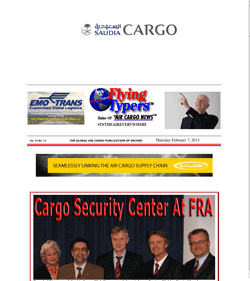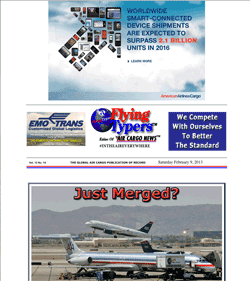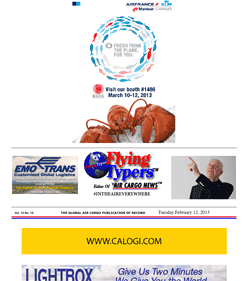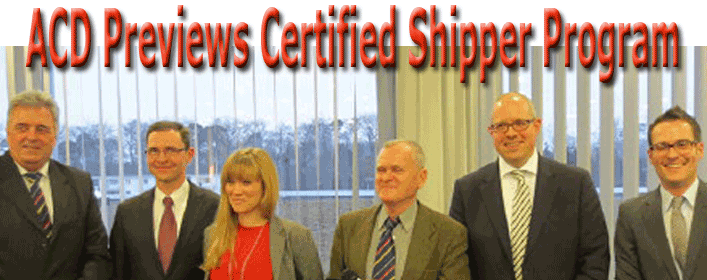 The
ACD Security Panel—left to right, Thomas Ritter, Senior
Manager Logistics for Fujitsu Semiconductor Europe; Marco
Jentsch, Leader of LBA Department S3; Bianca Bazant, Managing
Director of LFS; Wolfgang Plantholt; Patrik Tschirch, Managing
Director LUG and Jan Bender, Head of Foreign Trade Compliance
Air & Sea Logistics for Dachser. The
ACD Security Panel—left to right, Thomas Ritter, Senior
Manager Logistics for Fujitsu Semiconductor Europe; Marco
Jentsch, Leader of LBA Department S3; Bianca Bazant, Managing
Director of LFS; Wolfgang Plantholt; Patrik Tschirch, Managing
Director LUG and Jan Bender, Head of Foreign Trade Compliance
Air & Sea Logistics for Dachser.
 t was not bad for a mature air cargo club that will celebrate
its 50th anniversary in October: upwards of 120 people attended
this February meeting, nearly double the average showing
and a representative mix across the industry in terms of
both disciplines and age groups. The selection of the topic,
coming just six weeks ahead of the European Union directive
deadline, seems to have caught people’s attention,
whether they are looking for reassurance or belated clarification.
t was not bad for a mature air cargo club that will celebrate
its 50th anniversary in October: upwards of 120 people attended
this February meeting, nearly double the average showing
and a representative mix across the industry in terms of
both disciplines and age groups. The selection of the topic,
coming just six weeks ahead of the European Union directive
deadline, seems to have caught people’s attention,
whether they are looking for reassurance or belated clarification.
The format for the event was
a panel moderated by Wolfgang Plantholt, a longtime industry
insider and independent publicist, and four panelists who
represent the regulatory body: a shipper, a cargo handling
company, a freight global forwarder, and a cargo security
screening service provider. Starting things off, Thomas
Ritter, senior manager logistics for Fujitsu Semiconductor
Europe shared his experience with the certification program
from initial contacts with the LBA (Luftfahrtbundesamt,
the German equivalent of the FAA) in 2011 throughout 2012,
by which time his company had certified four trainers and
successfully passed the mandatory audit. Some of Fujitsu’s
largest customers are from the automobile industry and given
the high value aspect of these semiconductors, Fujitsu already
had a high level of security measures. Mr. Ritter said,
“our costs of becoming certified registered shippers
were relatively low” given that a solid relevant infrastructure
was in place. His was company number 284 on the list of
certified registered shippers in Germany.
From the forwarder perspective,
Jan Bender, head of foreign trade compliance air & sea
logistics for Dachser remarked that big firms were mostly
proactive in obtaining certification, while some looked
at balancing security and economics and left it for later,
which is always a challenge. Mr. Bender went on to say that
“we all share the same responsibility when it comes
to security.”
Bianca Bazant is the managing
director of LFS, an air cargo security firm—the equivalent
of the U.S. TSA’s Certified Cargo Screening Facilities
(CCSF) operating at FRA, HAM, and STR airports. At FRA,
LFS has 30 HI-SCAN 180180-2is X-ray cargo inspection machines
with tunnel dimensions of 1800 mm (71”) width and
1800 mm (71”) height, capable of screening pallets,
and LD-3. 2,000 tons have been processed using integrated
processes since installation.

Wolf-Dietrich von Helldorff, President of the Air
Cargo Club Deutschland welcomed the attendees and introduced
the Certified Shipper Panel.
As newly minted managing director
for LUG, an independent cargo handling company that has
been in business for more than 40 years, Patrik Tschirch
takes over for an old friend, Wolfgang Korte, who is retiring
next month. His expectation is that “an initial wave”
will occur at the startup of the new regime. The screening
procedures implemented are nearly entirely x-ray based and
currently explosive detection canine teams are a small component
of the security processes.
Marco Jentsch is Leader of
LBA Department S3, air carrier security programs; he gave
a brief overview saying that 1,072 individual locations
throughout Germany were certified, 400 applications were
being processed at this time, and on site audits conducted
by the department were ongoing, all geared up to meet the
March 25 deadline. The date actually prompted some back-and-forth
as April 29 has also been bandied around as a possible deadline,
creating some uncertainty. Mr. Jentsch explained that this
was a European Union matter and that March 25 remained the
official date. As on previous occasions, national interpretations
of EU mandates continue to be an irritant that most professionals
have learned to live with, shrugging it off with “it’s
the bureaucracy.”
Furthermore, Mr. Jentsch
remarked, “the use of canines is not seen as a decisive
factor.” Again, this is rather different from the
DHS/TSA multilayered approach.
Topics from the audience ranged
from temperature-controlled cargo shipped in specialized
ULDs larger than the maximum size of the certified screening
equipment, to products such as film, organic material, and
foods that spoil if exposed to x-ray. Art from museums presented
another set of challenges. The consensus was to encourage
moving the screening up the supply chain and carry it out
at the source as a certified registered shipper to avoid
“last mile” airport screening and its potential
impact.
The cost of the certification
program was raised because it is the legislature—the
Bundestag (national German parliament)—and not the
LBA as administrator, which sets the applicable fees, and
these have not yet been decided. The German elections scheduled
for Q4 2013 will play a role and it is conceivable that
any relevant rulemaking will be handed down after the election.
The pricing comprises the certification process with additional
costs for training and audit; these vary by the scope of
work subject to the size of the respective enterprise. Herr
Ritter of Fujitsu indicated their audit had two inspectors
working for four hours and that, in his experience, dealing
with LBA “is not that terrible.” While speculation
was rife with figures as high as EUR 50,000, Herr Jentsch
stated realistic fees were likely to be in the range of
EUR 1,500 – 5,000, albeit possibly retroactively.
An ongoing concern has been the strain on resources and
recruitment of additional staff from former military and
federal rail taking a “learning by doing” approach.
Currently, there are 34 staff working on certification;
there is an audit scheduled per quarter.
Additional questions concerned
whether the Certified Cargo Screening facilities was a “gold-digger”
opportunity, with Ms. Bazant stating that the equipment
and training were expensive, but screening is a business
like any other and LFS must invest.
Startup concerns brought some
generalized anxiety to the fore, with the fear of trucks
backed up into the Autobahn. Operational experience would
have to determine which weekdays and time of the day would
be problematic; scheduling is expected to be a key factor
going forward. Whether cargo will be segregated by certified
shipper and unscreened, it still remains to be seen how
the airport will handle it, and Mr. Tschirch said in his
view “a fast lane for certified cargo will be subject
to experience.”
Air cargo from certified shippers
is estimated at 355,900 tons, or between 15-20 percent of
the total. Expectations were
that air cargo would become more expensive and slower depending
on other factors, such as the uninterrupted custody chain
from certified shipper to airport, whether to use a seal
for a truck, and, according to Mr. Bender, whether there
was “close dialogue between shipper and forwarder
to ferret out bad actors.”
Again, varying European procedures
caused some cynicism. UK procedures and processes were judged
to be the strongest in Europe. Harmonization is the responsibility
of the EU Commission and remains a challenge.
Watch this space post March
25, 2013!
Ted Braun |

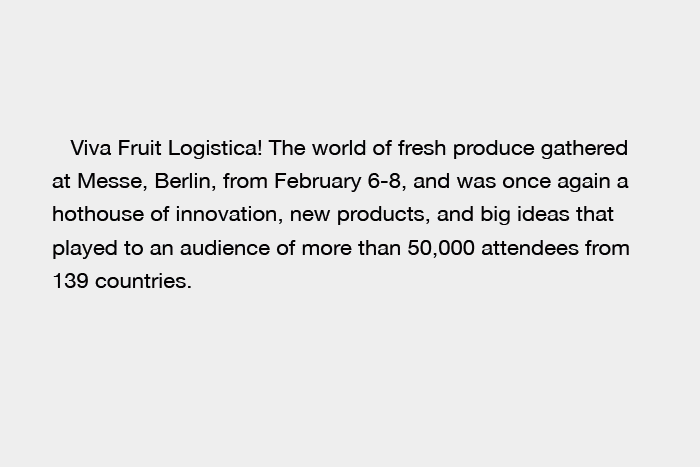
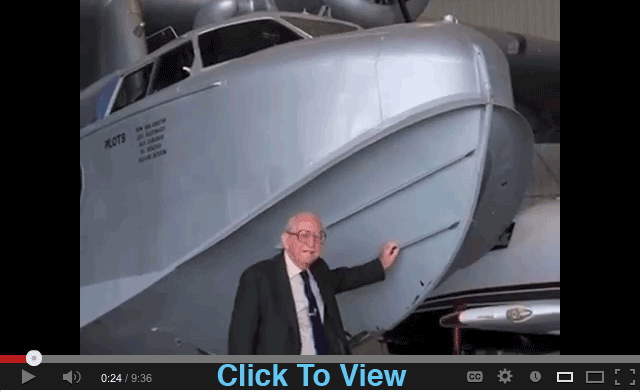
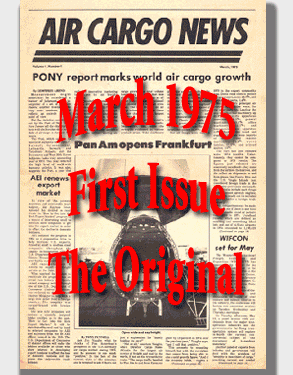




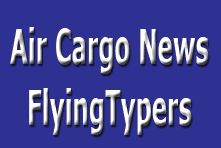
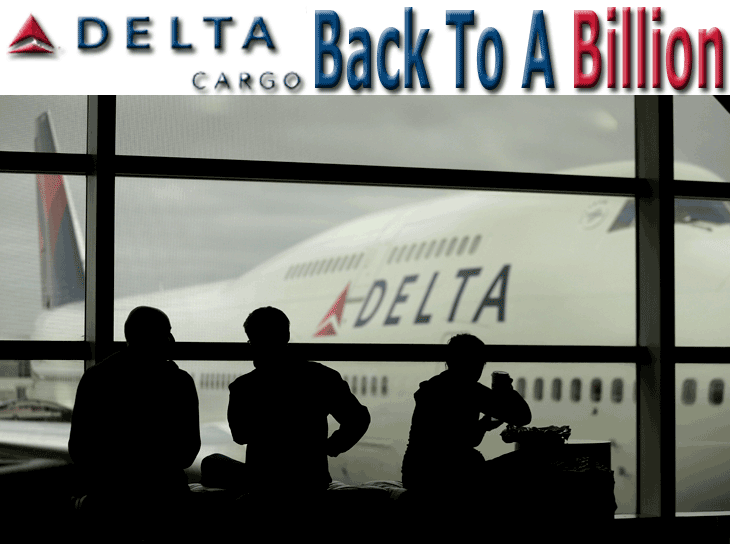

 nce upon a time he led
Delta Cargo.
nce upon a time he led
Delta Cargo.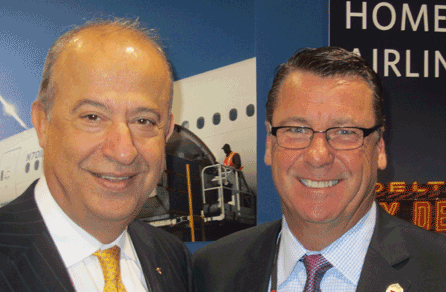
 The
ACD Security Panel—left to right, Thomas Ritter, Senior
Manager Logistics for Fujitsu Semiconductor Europe; Marco
Jentsch, Leader of LBA Department S3; Bianca Bazant, Managing
Director of LFS; Wolfgang Plantholt; Patrik Tschirch, Managing
Director LUG and Jan Bender, Head of Foreign Trade Compliance
Air & Sea Logistics for Dachser.
The
ACD Security Panel—left to right, Thomas Ritter, Senior
Manager Logistics for Fujitsu Semiconductor Europe; Marco
Jentsch, Leader of LBA Department S3; Bianca Bazant, Managing
Director of LFS; Wolfgang Plantholt; Patrik Tschirch, Managing
Director LUG and Jan Bender, Head of Foreign Trade Compliance
Air & Sea Logistics for Dachser.
 RE:
RE:
